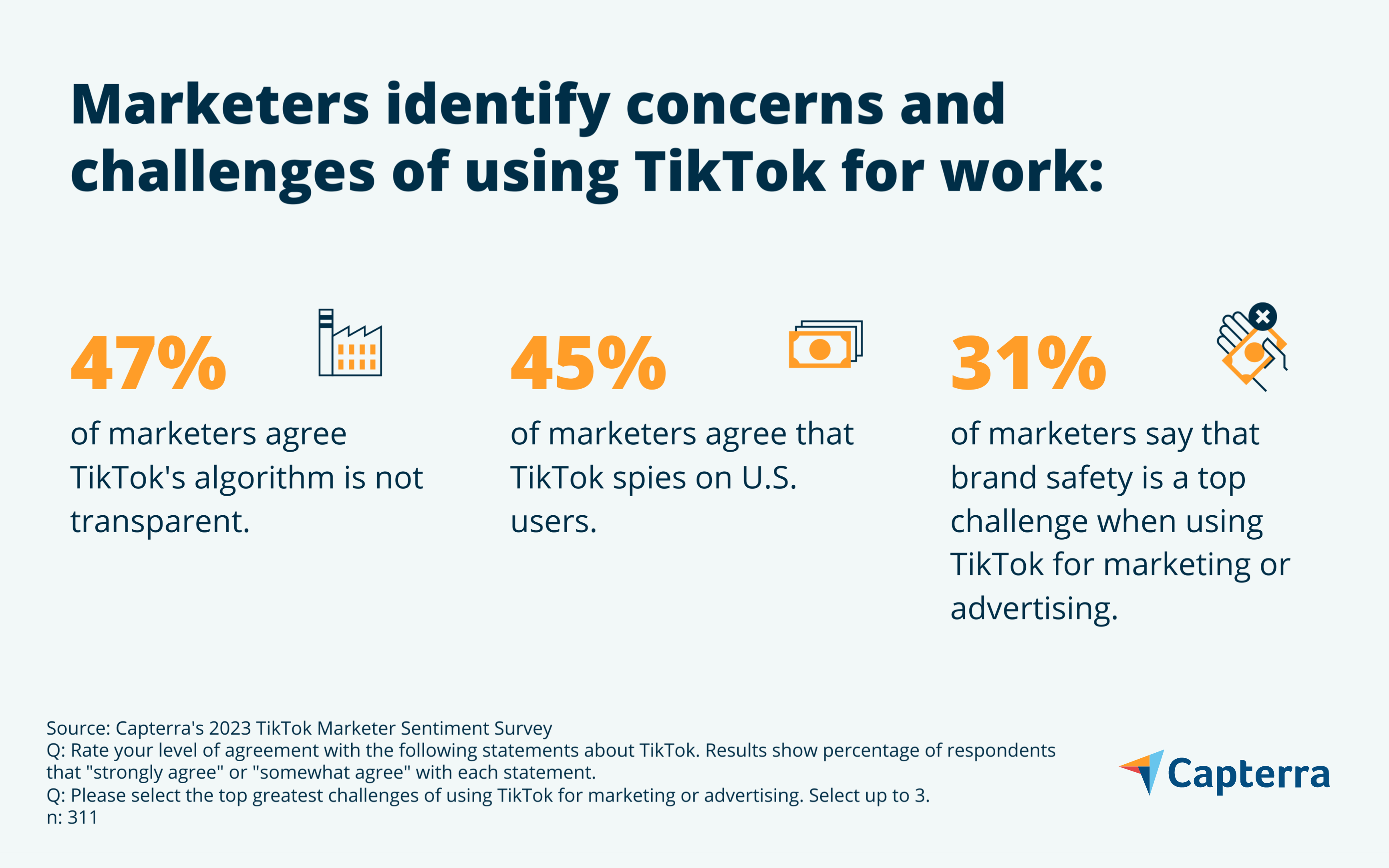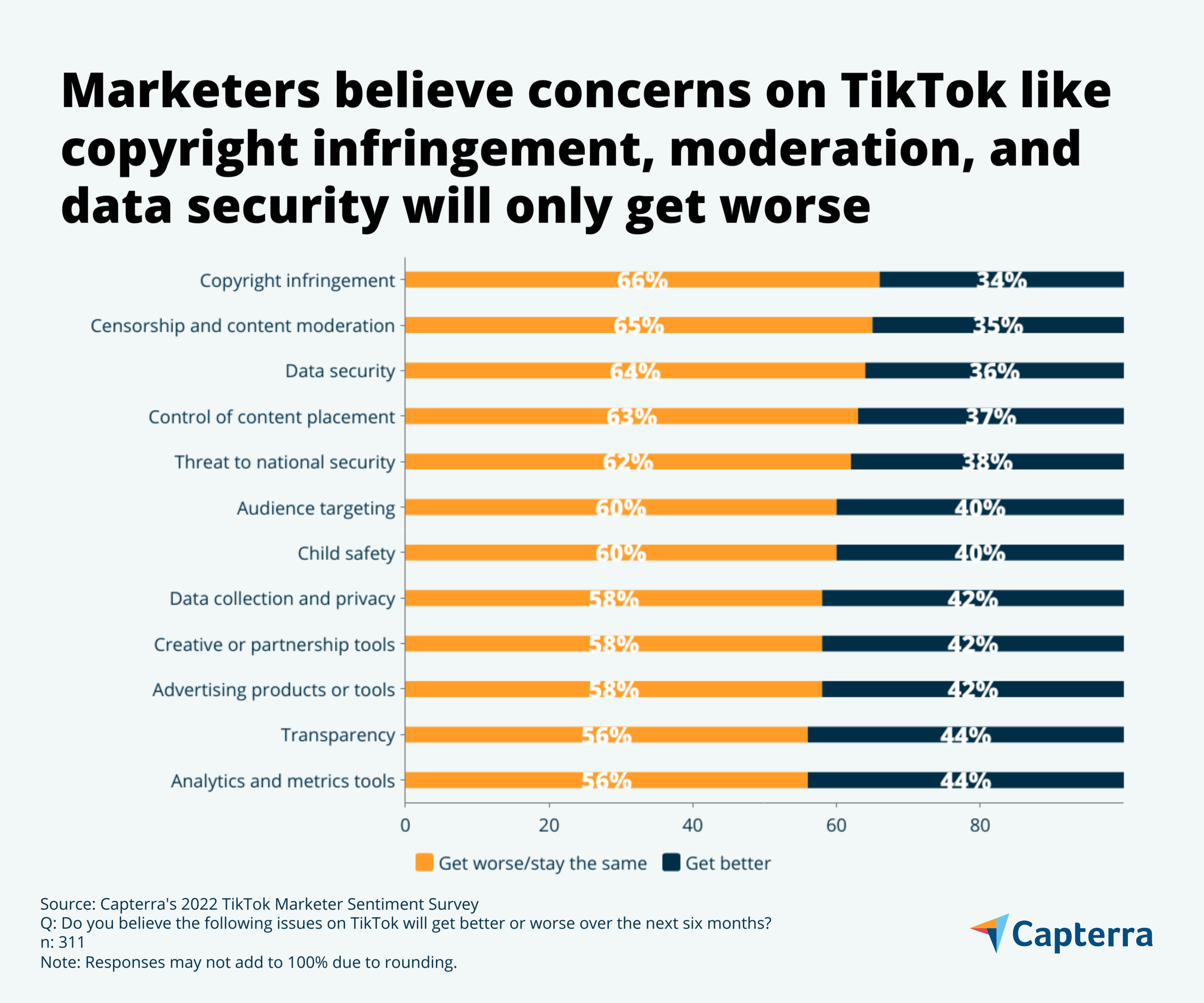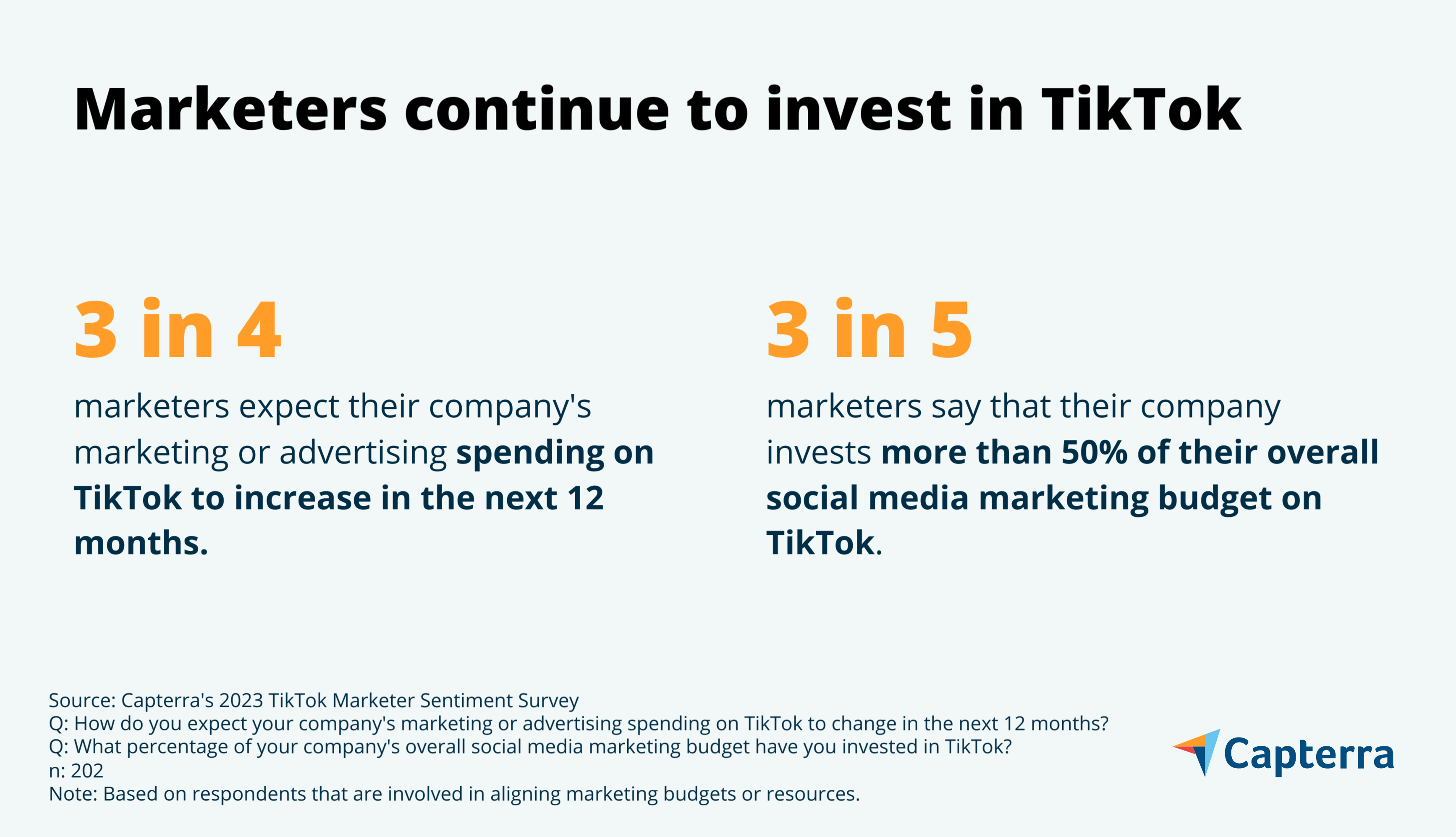Marketers will jump ship if they have to—learn how your business can prep for a ban
A potential TikTok ban in the U.S. is causing anxiety among businesses that have invested heavily in building a presence on the platform. Losing TikTok could have a big impact on marketing and advertising strategies. This is especially true for small business and direct-to-consumer (DTC) brands that rely on TikTok’s large audience to grow their online communities and create brand awareness.
Despite this, marketers remain committed to investing in the platform and steadfast that it will be a viable option for the long run. Capterra's TikTok Marketer Sentiment Survey reveals that three in four marketing professionals expect to increase spending on TikTok in the next 12 months, despite security and brand safety concerns*.
The following research will explore marketers’ current stance on TikTok, including which features or aspects of the platform they are most concerned about, and assess the best path forward given the platform’s ongoing volatility.
/ Key findings
Marketers say there are drawbacks to using TikTok: 59% of marketers agree that concerns over TikTok's data privacy and national security are justified. 47% agree that TikTok’s algorithm is not transparent, while 45% believe that TikTok spies on U.S. users. 31% of marketers say that brand safety concerns are a top challenge.
A national TikTok ban would undoubtedly impact businesses: 93% of marketers say that producing vertical or short-form video content is extremely or somewhat valuable to their company’s marketing objectives. 82% of marketers say that a TikTok ban in the U.S. would have a significant or moderate impact on achieving their company’s social media marketing or advertising objectives.
Despite heightened scrutiny from legislative bodies, most marketers believe a national ban is unlikely and continue to invest: 56% of marketers say that it is highly or somewhat unlikely that the federal government will ban or prevent TikTok from operating in the U.S. 87% of marketers believe that TikTok is a viable platform for long-term marketing strategies.
A diversified digital media strategy can help marketers be prepared in case of a ban: Facebook (80%) and YouTube (79%) rate as the most popular social media platforms marketers say they’d use as alternate platforms if TikTok were to be banned. However, 70% think their company should expand its presence in other digital channels such as email, mobile, or video.
Marketers acknowledge TikTok detractors and an uncertain future in the U.S.
TikTok has been locked in an ongoing battle with the U.S. government over threats to national security. The future of the app’s usage is now coming to a head and remains to be determined.
The platform owned by Chinese parent company ByteDance has already been banned on some state networks, government devices, and at public universities. The Committee on Foreign Investment within the U.S. Treasury Department is now calling for a nationwide ban[1] unless ByteDance divests from the platform. More recently, the CEO of TikTok was questioned[2] for nearly five hours in Congress about spying on American citizens, among other issues.
Marketers haven’t turned a blind eye to TikTok volatility. According to our research, 38% are aware that TikTok is under investigation by the Committee on Foreign Investment. Additionally, 32% are aware it is banned at some public universities and on some government-owned devices (41%).
A majority of marketers (59%) find that the data privacy and national security concerns are justified.
Marketers identify other TikTok concerns
Here’s a closer look at respondents' sentiments toward the app:

Searching for a social media marketing agency to help elevate your business? We’ve got you covered. Check out our list of companies in the following areas:
More than a third (34%) of marketers cite security issues as their greatest challenge when using TikTok for marketing or advertising. There are also varied opinions regarding how the app’s core features and functionality will evolve over the next six months:

Specifically, the rise of synthetic media (artificially-generated content) has raised concerns among 60% of marketers. AI software makes it more challenging to identify real vs. fake content and contributes to a growing risk of copyright and trademark infringement.
Nearly half (49%) of marketers say they have encountered a fraudulent brand or company account on social media. Another 46% say they have witnessed fraudulent brand or company spokespeople or representatives**.
Interested in learning more about how AI-generated content is causing concerns for marketers? Check out our recent report “Why Marketers Need a Brand Monitoring Strategy in the Age of AI”.
TikTok now states that AI creations depicting realistic scenes must be labeled in its recently updated community guidelines[3].
Marketers are most hopeful that transparency (44%), analytics and metrics (44%) will get better in the next six months likely due to the app’s recent efforts to influence U.S. policymakers.
TikTok’s safety and transparency resources
TikTok has made moves to fight a potential ban in the U.S. with the addition of new safety and transparency resources:
Community guidelines: TikTok has updated its community guidelines to include changes surrounding synthetic media (content created or modified by AI technology), hate speech or hateful behavior, and election integrity. The app claims it will provide additional training to its moderators to help enforce new updated standards and rules.
Transparency and accountability center: Our research found that 66% of marketers didn’t know that TikTok has a transparency and accountability center where guests have the opportunity to learn about source code and how their app’s algorithm operates. Additionally, TikTok published Transparency Reports to provide visibility into how the app upholds community guidelines and responds to requests for information.
Brand safety and suitability partners: 63% of marketers believe that the ability to control the placement of content will get worse or stay the same on TikTok over the next six months. Luckily, the app has recently announced partnerships with measurement partners DoubleVerify, Integral Ad Science (IAS), and Zefr. The goal is to help safeguard advertising on TikTok so that marketers can have more confidence that their brand campaigns will run adjacent to brand-suitable content that reflects the industry standards set by the Global Alliance for Responsible Media (GARM).
Marketers believe a TikTok ban is unlikely
Where do marketers believe we are headed? Surprisingly, 87% of marketers believe that TikTok is a viable platform for long-term marketing strategies.
Most have leaned into the notion that TikTok will continue operating in the U.S.—56% believe that the federal government is highly or somewhat unlikely to ban or prevent TikTok from operating.
These sentiments are shared when it comes to local and state government, with 52% of marketers citing that it is highly or somewhat unlikely that their state or local government will follow suit by banning TikTok.
Marketers are keen to keep investing in TikTok despite potential risks
Many marketers are holding to see how the app’s future plays out. Eighty-two percent of marketers say that a TikTok ban in the U.S. would have a significant or moderate impact on achieving their company’s social media marketing or advertising objectives.
It’s a hard sell to abandon the app completely as TikTok is among one of the most popular social media platforms in the world. Marketers say that the top benefits of using TikTok are:
The app's ability to gather customer feedback and insights (38%)
Increased sales (38%)
Increased brand or product awareness (36%)
Even among marketers that believe data privacy and national security concerns are justified, 89% remain satisfied with their company’s TikTok marketing or advertising initiatives. Another 84% believe that the app continues to be a viable platform for long-term marketing strategies.

What’s next for your marketing team if TikTok shutters?
Social media platform uncertainty is nothing marketers and advertisers haven’t seen before. Historically, we’ve seen social media platforms rise and fall —MySpace, Friendser, Google+, and Vine, just to name a few. That’s why it’s essential that marketers and advertisers have a plan in place if TikTok is no longer a viable option.
Reallocating some of your digital marketing or advertising budget could be an attractive option to stay ahead of social media volatility. Our research finds that 70% of marketers believe their company should expand its presence in other digital media channels (excluding social) if TikTok were banned in the U.S. Consider moving resources into digital channels such as email or mobile marketing where it makes sense for your company.
In fact, 65% of our survey respondents say they would develop a new social media strategy altogether if TikTok were banned in the U.S.
Are you considering hiring a social media marketing agency for strategy help? Review our list of top social media marketing agencies and learn more about their services in Capterra’s hiring guide.
Three in five (61%) marketers say they would move to alternative social media platforms in the event of a TikTok ban. Facebook (80%) and YouTube (79%) are among the top alternatives. Surprisingly, only 67% say they would go to Instagram, potentially due to frustrations with the platform's constant algorithm changes[4].
With many social platforms available, it can be a challenge to choose which to invest time and resources in. Below are three actions you can take to help determine which platforms to advertise on:
Identify the top platforms your target audience uses. Media planning tools, market research, and demographic information supplied by the platforms can help you find the right social networks to consider. Another great place to get a sense of how platforms align with your target audience’s demographics is with Pew Research Center’s Social Media Fact Sheet[5]. Additionally, don’t forget to reach out to your sales or customer service teams. They can provide valuable insight to help you find out where your audience is actively engaged.
Pay attention to how each platform is structured and how your customers interact with it. Just because your audience is on social media doesn’t mean that your content will be relevant to them as they use each network. Understanding each platform can help guide where it makes most sense for your brand to engage with customers. For example, TikTok is focused on creative expression and encourages sharing through video. Brands can create the same form of creative expression in their TikToK content by working with influencers to increase brand awareness. YouTube, on the other hand, provides a video library where users listen, share, and build communities. This platform works great for increasing brand awareness via demos, training, or educational presentations.
Focus on quality by identifying the platforms with the biggest opportunities for your brand. Although your audience might use multiple social networks, it’s ideal to not spread yourself too thin. For example, some platforms might have limited reach but work better for your audience’s gender or age group distribution. This is where clearly defining your social media goals is important. What do you want to achieve with social media? This will help determine not only the platform, but your content strategy. Some common objectives for a social media strategy include driving leadings, increasing brand awareness, reaching new audiences, driving traffic, or increasing engagement.
Social media platforms like TikTok play a unique role in reaching your target audience. Wise marketers should always plan ahead, be flexible with their budget allocation, and diversify to stay ahead of uncertainty. Additionally, it helps to stay knowledgeable regarding platform capabilities, changes, and more importantly safety and transparency resources.
If like this report, check out other insights on marketing trends:

